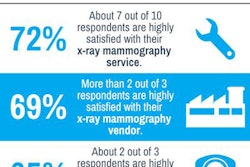The deep convolutional neural network (DCNN) was created to transition knowledge from nonmedical images to medical imaging interpretation tasks through supervised training. The study, led by Ravi Samala, PhD, a research investigator in the university's radiology department, compared the multitask transfer learning (MTTL) approach with a traditional single-task transfer learning method for classifying malignant and benign masses in mammography.
Samala and colleagues created heterogeneous mammography datasets of film-screen mammograms and digital mammograms from some 2,300 mammograms containing more than 2,400 lesions. With data augmentation, 19,688 regions of interest containing biopsy-proven masses were obtained.
Through multitask learning, the transfer network was schooled on three tasks from three institutions, while the single-task learning approach was trained with film-screen mammography data from the University of Michigan alone. Using the training set, a fourfold case-based cross-validation was performed to select the best training strategy in terms of the depth of convolutional layers that should be "frozen" during transfer learning.
When using transfer learning for DCNNs, multitask supervised learning showed better generalization to unknown cases than single-task learning, the researchers concluded.
"The MTTL DCNN framework for classification of masses in mammography has the potential to be extended to digital breast tomosynthesis while utilizing auxiliary tasks from large [film-screen mammography] and [digital mammography] datasets," Samala and colleagues wrote.



















